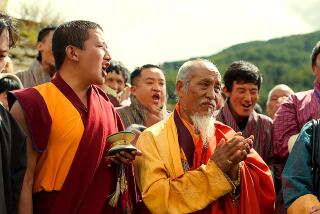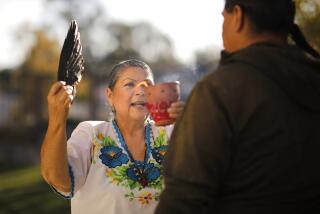East Meets West in Bhutan Health
- Share via
THIMPHU, Bhutan — Silver earrings dangling in wisps of her pixie-cut gray hair, Tshering Chenzon leans forward on a stool with her blouse pulled up from behind while a doctor’s aide aims a small garden hose at her lower back.
The hose is connected to a pot of water, boiling with 27 traditional medicines on an electric burner, and Chenzon, 56, is on her fourth visit to Bhutan’s Institute of Traditional Medicine Services for treatment of her pain.
Another patient is having acupressure. A doctor presses, but does not prick, her skin with the tip of a heated golden needle. Traditional doctors in this Buddhist kingdom in the Himalayas say conductivity varies with different metals, shapes, temperatures and the part of the body touched.
The instruments for nasal irrigation, bloodletting, massage and stone-heated baths are nearby. The institute’s walls have charts of pulse and “humor” points. Traditional doctors make their main diagnosis by feeling the pulse, checking urine, the eyes and tongue and from interviewing the patient.
A Buddhist monk may get more benefit from the treatment than a Westerner of another religion, says the institute’s director, Pema Dorji.
“Medicine is medicine,” Dorji says. “It should be the same for all. But when we talk about medical treatment, psychology also plays a role.”
He says the major difference between traditional and Western medicine is that “in our system we target organs, while in modern medicine, the targets are microorganisms.”
Traditional medicine has been an official part of Bhutan’s public health system along with Western-style medicine for more than three decades. The institute treats chronic diseases such as arthritis, rheumatism, and liver and nervous disorders. Patients with acute diseases, such as cancer, are referred to a Western-style hospital.
Sprawled on a hilltop in the capital, with the traditional arts center and national library just below, the institute also trains traditional doctors and conducts research on Bhutan’s wide variety of plants to develop new cures and identify the ingredients in centuries-old remedies.
Nomadic yak herders are employed to gather new plants when researchers go out to interview village healers.
“The village healers are not wrong,” says Dorji, who studied in Tibet before it was closed off by the Chinese takeover in the 1950s. “What they are doing is beneficial to the people sometimes. But their methods are crude.”
For bloodletting, healers would use unsanitary blades, for example. The institute uses outreach clinics to encourage healers to change some practices and improve others.
For instance, leeches are used for bloodletting in some parts of Bhutan. They are plentiful in the lower valleys in the monsoon season, and Dorji says they are better than a dirty blade and less traumatic for a patient whose blood pressure rises as he contemplates being cut.
“There are two kinds of leeches. One sucks. The other is poison. A person has to be well qualified to identify them,” he says.
Bhutanese fought off Tibetan and British attempts to take over their territory and remained isolated from foreign visitors until 1974, allowing protection of many rare plants and animals.
Medicines made from grinding those ingredients into powders, teas, pills, lotions and syrups are sold at the institute and are stored in airtight containers in pristine rooms.
With aid from the European Union, the institute began in the 1980s to produce pills, which allows for a more exact dosage than powders wrapped in papers. Also, most herbal medicines--taken with hot water on an empty stomach--are bitter, so a pill is easier to swallow.
“The reason for using this modern technology for manufacturing is we are keeping in mind we may export,” says research assistant Sonam Dorjee. “For example, it may go to America, where we would have to comply with FDA [Food and Drug Administration] rules.”
Traditional medicine became part of the public health system in 1967, and the government plans to have a traditional medicine center and a Western hospital in all 18 districts of the 46,500-square-mile country by next year.
“Government policy is to give a choice to patients and to do cross-research to find which system is best for a disease,” Dorjee says.
Dorjee dreamed of being a doctor, but his family of 10 could not afford medical school. Now he spends most of his time on computers, mapping the chemical contents of the minerals, plants and animal parts that make up the medicines that Himalayan monks and village healers have used for centuries.
The institute has a library of recipes as old as 400 years, collected from monasteries, written out in ink on bound pieces of paper twice the size of a checkbook and wrapped in silk.
*
New Agriculturist site on Bhutan: www.new-agri.co.uk/00-1/countryp.html
More to Read
Sign up for Essential California
The most important California stories and recommendations in your inbox every morning.
You may occasionally receive promotional content from the Los Angeles Times.













